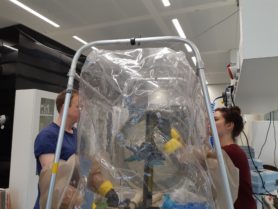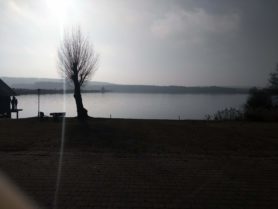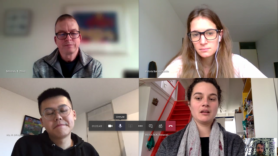Blogs
SEDEX training at Utrecht University
This is our first P-TRAP blog on Secondments. Secondments are an essential part of our training network. They give the ESRs the chance to visit partner universities and institutions, and our non-academic partners. In this way expertise and know-how is exchanged – a very useful experience and one of the major strengths of a research network!
Each ESR has 3 secondments planned throughout the project. On this opportunity, Karel and Victoria joined Melanie in March 2020 at Utrecht University. The objective of this secondment was training on specific lab skills. Caroline Slomp, Melanie’s promotor, has worked extensively on sequential extraction methods for sediments and had greatly contributed to the development of SEDEX, the sequential extraction method that we were going to use. Thus there is lots of expertise regarding this topic in Caroline’s research team. After Melanie had been trained on the method, she now transferred this knowledge to Karel and Victoria.
This secondment is also an excellent opportunity to catch up on each other’s work. Melanie is working on the long term effect of Iron addition in shallow dutch lakes. Karel’s research is closely related, he is investigating deeper lakes in Germany at Bayreuth University. The dynamics of shallow lakes and deep lakes are different, shallow lakes are usually completely mixed and deep lakes exhibit temperature stratification which prevents mixing and may lead to bottom water anoxia during stratified periods. Thus collaboration allows for much bigger data sets and the opportunity to compare systems if the same methods are used. One of Melanie’s secondments will be at Bayreuth University to get training on methods that Bayreuth has expertise on.

Joined work at the lab
The phosphorous sequential extraction takes about a week and is quite time intensive. So we started at 7 am and finished around 6 pm for the first 3 days. Of course, that is more fun in a team and we also shared some time with Mingkai who was also working in the lab. Unfortunately, on the last day of the experiment special measures were taken on a national level due to the coronavirus pandemic and some results are still on hold. But luckily we made it all the way to the step where samples can be stored oxically, so they can be stored with no danger of being altered until we are able to return to the lab and no results will be lost.
But wait a second, what did we do exactly? And why? The phosphorus (P) sequential extraction SEDEX was proposed by Ruttenberg in 1992 (1) and modified by Slomp et al. in 1996 (2). The SEDEX was developed to distinguish the chemical pools of P in marine, estuarine and lacustrine sediments. Doing this is not trivial, since small changes in the environment like a change in the O2 concentration, pH, redox potential and abundance of other elements may lead to a P exchange among pools. Yet distinguishing these pools is essential to understand the biogeochemical processes taking place in the sediment. Understanding the biogeochemical processes on the other hand is necessary to be able to determine the ability of sediment to bind P and the conditions under which it is able to do so. For example, we can see whether P is bound in the sediment on the long term, which other elements have an influence on the dynamics of P binding or release and so forth.
With SEDEX we distinguish 5 pools of P: exchangeable P (adsorbed or loosely bound P), Fe-bound P (coprecipitated or strongly bound P, also extracts Mn-bound P), Ca-bound P (authigenic P including P from carbonate fluorapatite, biogenic apatite, and P associate to CaCO3), detrital P (detrital apatite) and organic P. (1) This technique can also be applied to river sediments. In previous research done by Bas van der Grift (3) this technique helped understand the importance of iron-bound phosphorus particles in the total phosphorus transport downstream.

Melanie & Thilo slicing the core
SEDEX is a great source of information, but it is very time-consuming. And the actual process does start long before the lab. First, one needs sediment cores, undisturbed, well preserved and processed as fast as possible under anoxic conditions. After the cores have been taken, they need to be sliced in a glove-box, glove-bag, glove-tent or anything that can be filled with inert gas and worked in. Once the sediment has been sampled layer by layer, the porewater is removed by centrifugation and kept under anoxic conditions for further analysis. The sediment is then freeze-dried and ground to powder in the glove-box. Only now, we are good to go with our extraction.
Melanie performed the extractions on a sediment core from lake Sloene in the Netherlands and Karel brought core samples from lake Brombachsee in Germany. Lake Sloene has been overloaded with P for a long time already and several measures have been taken in the past to ameliorate its trophic state. One of those measures was the addition of FeCl3 in the 1990ies. Thus it is a suitable lake to investigate whether adding Fe is a way to bind P in the sediment on the long term. The Brombachsee suffers from harmful algae blooms in spring and summer, likely due to phosphate released from the sediment. Remediation is definitely wanted. To better understand the role of the sediment it is essential to know what routes of mobilization take place in the sediment. Victoria did not have samples on her own yet to process, but will use the method to distinguish P pools in the sediments of agricultural drains and ditches to understand what happens with the P right after it is flushed from the fields into the waterways.

Picture of Brombachsee in Germany the day Karel took the core
The sediment is a messy place and phosphate is bound in all types of ways. Phosphate can combine with iron, aluminum, and organic molecules. The problem is that all these phosphates will be released differently and to varying extents. Some fractions might not contribute at all to phosphate release in the water column while others are very important. The presence of phosphate alone is therefore not accurate enough to predict if the sediment is an important source of phosphate for algae. With sequential extraction one is able to get a more nuanced idea about the sediment`s composition and this will help us to discover the role of the lake sediment in eutrophication and what type of changes take place therein.

Microsoft Teams FOTO
Initially, the secondment was planned to last about 3 weeks, including lake sampling and sample processing, SEDEX and also more training on iron and sulfur sequential extractions by the members of Caroline Slomp’s research team. However, due to the measures taken to stop the spread of the Coronavirus, the labs were closed and we had to stop after one week. However, the first step is taken and now that Melanie showed Karel and Victoria how to use this method our results on P in sediments will be comparable. Thank you Melanie and we hope to welcome you in Bayreuth and Deltares soon! But for now, we will have to use video calls to keep each other up to date.
References:
1. K.C. Ruttenberg, Development of a sequential extraction method for different forms of phosphorous in marine sediments, Limnol. Oceanogr., 37(7), 1992, 1460-1482.
2. C. Slomp et al., A key role for iron-bound phosphorous in authigenic apatite formation in North Atlantic continental platform sediments, Journal of Marine Research, 1996, 54, 1179-1205.
3. van der Grift, B., Osté, L., Schot, P., Kratz, A., van Popta, E., Wassen, M., & Griffioen, J. (2018). Forms of phosphorus in suspended particulate matter in agriculture-dominated lowland catchments: Iron as phosphorus carrier. Science of the Total Environment, 631–632, 115–129. https://doi.org/10.1016/j.scitotenv.2018.02.266

